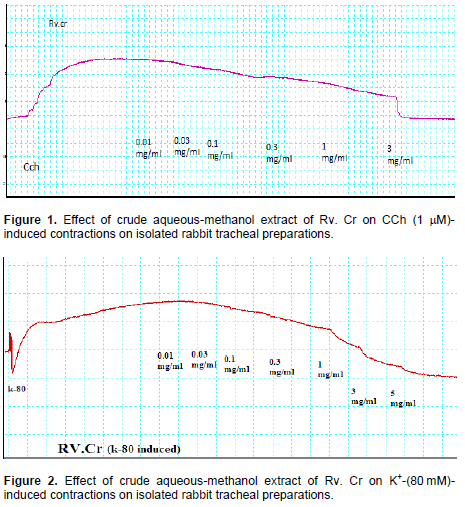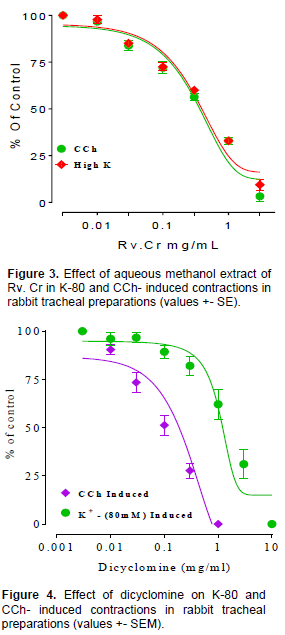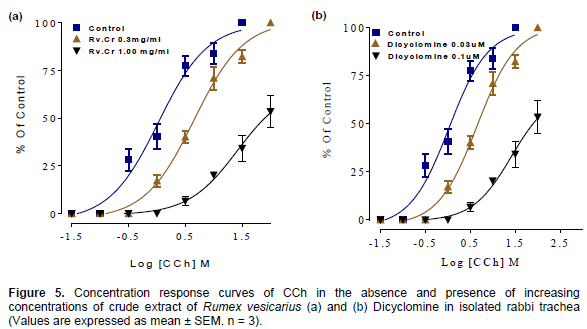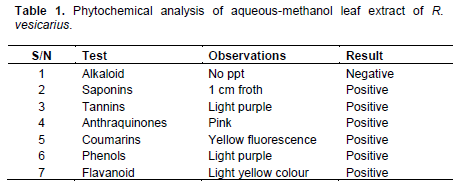ABSTRACT
Rumex vesicarius L. has traditionally been used in folkloric medicine to manage respiratory disorders. The present study was designed to evaluate the effect of aqueous-methanol extract of R. vesicarius on isolated rabbit tracheal preparations, an attempt to validate its folkloric use in traditional medicine for respiratory ailment. The application of the extract to isolated rabbit tracheal preparations relaxed completely the carbachol-(1 μM) induced contractions (0.01 to 3.0 mg/mL) as well as K+-(80 mM) induced contractions (0.01 to 5.0 mg/mL). These effects were found comparable to that of dicyclomine, as an antagonist of muscarinic receptors as well as a possible Ca++ channel blocker. The previously mentioned findings may partially justify the folkloric use of R. vesicarius in the management of conditions pertaining bronchitis, asthma, chronic obstructive pulmonary disease and airy way congestion.
Key words: Rumex vesicarius, asthma, trachea, congestion, dicyclomine.
Rumex vesicarius L. is the most prominent member of family Polyconaceae, locally known as “Khat palak” in south Asia. Fresh juice of R. vesicarius L. leaf has been used traditionally used as a cooling agent, astringent, anti-venom agent and appetizer for the treatment of allay pain of toothache, nausea, and insect bite, seeds were used for dysentery (Dymoke, 1972). In Ayurvedic system of medication, it was used as stomachic (Ahirrao and Patil, 2012), anti tumor, analgesic, flatulence, spleen disease, high cough, asthma, laxative, bronchitis, dyspepsia, heart troubles, alcoholism and biliousness (Kirtikar and Basu, 1987). In Unani system of medication, it was used as tonic leucoderma for scabies and diuretic (Kirtikar and Basu, 1987). In other folk medicines, it was used to eradicate piles, constipation and hiccup (Hariparasad, 2011). Reptile insect, urinary affection, hepatoprotective, dysmenorrhoea, blood purifier, depurative, sedative, alkalinity, chronic catarrh, renal disorders, dyspepsia, bloody dysentery and coronary (Madhavashetty et al., 2008), vomiting (Khan et al., 2013), leucoderma, antiviral, lymphatic glyndular system disease, antidiabetic, rectal prolapsus, aphrodisiac anti-cholesterol, impetigo and carbubuncles (Pullaiah and Ali, 1997), antioxidant (Rao, 2003), anthelmintics (Rao et al., 2012), stomach ache, cancer and inflammation (Aggarwal et al., 2006), spasmogenic and spasmolytic (Khan et al., 2014), diuretic (Rao et al., 2011), anti-fungal (Amira et al., 2011), and antipyretic (Khan et al., 2013). This study reports the bronchodilator activity of aqueous - methanol leaf extract of R. vesicarius Linn and its fractions in air way passage.
Plant material
Indigenous medicinal plant R. vesicarius L. was collected from the sandy fields of Mondka Shahjamal District, Muzaffar Garh, Pakistan. The plant material was authenticated by expert taxonomist, Professor Dr. A. H. Dasti at the Department of Botany, Bahauddin Zakariya University, Multan, Pakistan (voucher F.P.ST-215). The plant material was made free from foreign adulterants and vegetative debris by hand picking and leaves were detached from the plant, washed and shade dried. Within 8 days, leaves became crispy. Special electrical herbal grinder was used to form coarse powder. Uniform dark green powder was obtained with characteristic smell.
Crude extract
The powdered plant material (1 kg) was subjected to maceration in 70% methanol in amber coloured glass bottle at room temperature (25°C) for 8 days with occasional shaking (Aziz et al., 2013a). The soaked material was passed through muslin cloth to remove the vegetative material and the fluid obtained was filtered through Whattman-1 Filter paper. The filtrate was evaporated on a rotary evaporator (Rotavapor, BUCHI Labrotechnik AG, Model 9230, Switzerland) at 37°C under reduced pressure. Approximate yield was 11% and the extract obtained was stored at -4°C in air tight jars in lab refrigerator.
Preliminary phytochemical screening
Vital phytochemical classes were screened by the method described by Aziz et al. (2013b).
Chemicals and drugs
All the chemicals, solvents, and drugs used were of analytical grade. Carbacholine was purchased from Ethical Laboratories Pvt. (Ltd) Pakistan. Dimethylsulfoxide, ethylenediamine tetraacetic acid, glucose, magnesium chloride, magnesium sulfate, potassium chloride, potassium dihydrogenophosphate, sodium chloride, sodium bicarbonate, and sodium dihydrogenophosphate were purchased from Sigma Chemical Company, St. Louis, MO, USA. Calcium chloride was purchased from Merck (Merck, Darmstadt, Germany).
Animals and housing condition
Fifteen adult albino rabbits (1.0 to 1.5 kg) of either sex, purchased from the animal market Hussain Agahi Multan, Pakistan with age limit between 6 to 7 months were used for the experiments. Animals were provided with fresh green fodder and tap water ad libitum and maintained in air conditioned room (23 to 25°C) at the Faculty of Pharmacy, Bahauddin Zakariya University, Multan. All rabbits were kept in fasting condition for at least 24 h before the commencement of experiments, but had free access to water. The experiments were approved by the Ethical Committee of the Bahauddin Zakariya University, Multan with reference number EC/12/2012 dated 07 December, 2012.
Plant extract solution
The plant extract (0.3 g) was dissolved in 1 ml of methanol to produce stock solution from this stock solution further dilutions were made. Solutions were freshly prepared on the day of experiment.
Isolated rabbit tracheal preparation
The trachea was dissected out and cut into rings of 3 to 4 mm in width, each ring contains about two cartilages for the formation of tracheal strip, and each ring was opened by a longitudinal cut on ventral side opposite to the smooth muscle layer with a central part of smooth muscle sandwiched between cartilaginous portions on the edges. The formed tissue preparation was then suspended in a 10 mL tissue bath containing Krebs physiological salt solution at 37°C and aerated with carbogen. For calibration about 1 g tension was applied to each of tracheal strips; this tension remained constant throughout the experiment. The isolated rabbit tracheal preparation was equilibrated for 45 min prior to recording isometric contractions via force displacement transducers connected to a Powerlab Data Acquisition System (AD Instruments, Sydney, Australia) which was displayed on a computer running Lab Chart version 6. The relaxant effect of the test material was assessed on carbachol-(1 μM) and K+-(80 mM) induced contractions in isolated rabbit tracheal preparations as the cumulative addition of the test material to the isolated tissue bath may relax the isolated rabbit tracheal preparation. The isolated rabbit trachea preparations were equilibrated for 45 min prior to the addition of any test substance. Carbachol (1 μM) and K+ (80 mM) were used to produce sustained contractions in isolated rabbit trachea preparations on which the possible tracheal relaxant activity of the extract was studied following addition to the tissue baths in a cumulative manner in comparison to control drugs. The cumulative concentration response curves for carbachol were constructed through cumulative increase in concentration of agonist in tissue bath till a 3-fold increase in cumulative concentration did not produce further increase in response. The tissues were washed to re-establish the base-line tension, and concentration response curves (CRCs) for CCh were prepared in the presence of different concentrations of the aqueous-methanol extract and the standard drug dicyclomine (Gilani et al., 1997).
Statistical analysis
The results for spasmolytic and spasmogenic activities are expressed as the mean ± standard error of mean (SEM). EC50 values with 95% confidence interval were calculated using the computer software GraphPad Prism program version 6.0 for Windows (GraphPad, and San Diego, USA). Dose-response curves were analyzed by nonlinear regression sigmoidal response curve (variable slope).
Preliminary phytochemical screening detected the presence of tannins, phenols, saponins, anthraquinones and coumarins as constituents of the crude aqueous-methanolic extract of R. vesicarius (Rv. Cr), while it tested negative for the presence of alkaloid.
When tested on isolated rabbit tracheal preparation, Rv. Cr caused complete relaxation of CCh (1 µM) and high K+(80 mM)- induced contractions in rabbit tracheal preparation in concentration-dependent manner at dose ranges of 0.01 to 3.0 mg/mL and 0.01 to 5.0 mg/mL (Figures 1 and 2) with respective EC50 values of 0.5040 mg/ml (0.3470 to 0.7319, n = 5) and 0.4591 mg/ml (0.3277 to 0.6431, n = 5), (Figure 3). Similarly, dicyclomine also caused the relaxation of CCh (1 uM) and high K+(80 mM)- induced contractions with respective EC50 values of 0.339 uM (0.272 to 0.420, n = 4) and 3.30 uM (2.399 to 4.54, n = 4), (Figure 4). Pretreatment of tracheal preparation with Rv. Cr at concentration range (0.3 mg/ml) shifted the CRCs to the right, parallel without suppression of maximum contractile response, while at concentration range (1 mg/ml) shifted the CRCS to the right, non parallel way with the suppression of maximum contractile response (Figure 5a) in a manner similar to that of dicyclomine (Figure 5b).



Phytochemical analysis of crude leaf extract of R. vesicarius (Rv. Cr) showed the presence of saponins, tannins, anthraquinones, coumarins, phenols, and flavonoid, while the alkaloid was absent as aqueous-methanol soluble constituents (Table 1). Rv. Cr has traditionally been used for the relief and treatment of various respiratory disorders such as asthma, bronchitis, cough, and congestion of the airway (Kirtikar and Basu, 1987). For the evaluation of possible tracheal relaxant activity, Rv. Cr was tested on carbachol-(1 μM) and K+-(80 mM) induced spastic contractions on isolated rabbit tracheal preparations (Figures 1 and 2). Rv. Cr showed relaxant effect on both induced contractions, but CCh-induced contractions were relaxed at lower concentration in comparison to K+-(80 mM) induced contractions in a similar manner as dicyclomine. CCh induces contraction by stimulation of muscarinic receptors (Jenkinson, 2002). Hence, the relaxation of airway muscles after the administration of the aqueous-methanol extract of R. vesicarius was found to be due to the dual mechanism (that is, muscarinic antagonist and Ca++ channel blockade). The bronchodilator effect may possibly be mediated through Ca++ channel blockade (Ahmad, 1992).

Interestingly, muscarinic antagonists are among the drug of choice today used in the treatment for the relief from asthma and chronic obstructive pulmonary disease (Boushey, 2006). As bronchiolar smooth muscles is regulated by the autonomic nervous system (parasympathetic division), and the increase in parasympathetic activity may results in bronchoconstriction, because respiratory tract is rich in M1 muscarinic receptors linked to vagal fibres present in the mucosal surface of the respiratory tract. Mucus of the submucosal glands results in increased pathological miseries. This is the reason for which M1 and M3 receptors blockers are attaining attentions for the use of asthma as well as COPD (Barnes and Hansel, 2004).
These results were further confirmed as the aqueous-methanol extract of R. vesicarius at a low tissue bath concentration of 0.3 mg/mL, displaced the CCh-concentration response curves to the right, in a similar manner without suppressing the maximum dose response while increasing the tissue bath concentration to 1 mg/mL, the log concentration response curve of carbachol was shifted to right in non-parallel manner with the suppression of the maximum response. The parallel shift of CCh-concentration response curves at 0.3 mg/mL of the extract without suppression of maximal response can be indication of antagonism of muscarinic receptors in competitive manner, while the nonparallel shift of CCh-concentration response curves at 1 mg/mL of the extract with suppression of maximum response can be attributed to the presence of some components capable to exert Ca++ channel blocking effect. Clinically, Ca++ channel blockers are used to relax tracheal disorders of hyper responsiveness of the respiratory system (Kamei and Kasuya, 1992). These results support the traditional use of R. vesicaius in respiratory disorders including asthma, cough, bronchitis, COPD and respiratory congestion.
Aqueous-methanol extract of R. vesicarius was found to possess tracheal relaxant activity. The tracheal relaxant activity was mediated via anticholinergic and calcium channel blockade mechanism. This study may provide a pharmacological basis to validate the traditional use of R. vesicarius in the management of respiratory disorders.
The authors are thankful to MS. Fatima Saqib for her guidance throughout the experiment.
The author(s) have not declared any conflict of interest.
REFERENCES
|
Ahirrao YA, Patil DA (2012). Ethnomedicinal claims against stomach complaints in Buldhana District (Maharashtra, India) Life sci. Leafl. 1:16-25. |
|
|
|
Ahmad T (1992). Calcium antagonists: potential for asthma therapy. Choices Respiratory Manage. 22:41-43. |
|
|
|
Amira M, Abu T, Kadriya E, Fatimah OA (2011). Assessment of antifungal activity of Rumex vesicarius L. and Ziziphus spina-christi (L.) Willd. extracts against two phytopathogenic fungi. Afr. J. Microbiol. Res. 5(9):1001-1011. |
|
|
Aggarwal BB, Ichikawa H, Garodia P, Weerasinghe P, Sethi G, Bhatt ID, Pandey MK, Shishodia S, Nair MG (2006). From traditional Ayurvedic medicine to modern medicine: identification of therapeutic targets for suppression of inflammation and cancer Expert Opin. Ther. Targets. 10(1):88-118.
Crossref |
|
|
|
Aziz A, Khan IA, Munawar SH, Munzoor Z, Agha S (2013a). Evaluation of antitussive activity of Lycopus europaeus on cough reflex induced by different cough induced models in mice. Int. J. Pharma. Sci. 3(6):412-416. |
|
|
|
Aziz A, Khan IA, Munawar SH, Sadr-ul S (2013b). Antipyretic study of methanolic bark extract of Plumeriar ubra, linn. In various pyrexia induced models", Int. J. Res. Dev. Pharm. L. Sci. 2(6):680-685. |
|
|
Barnes PJ, Hansel TT (2004). Prospects for new drugs for chronic obstructive pulmonary disease. The Lancet. 364(9438):985–996.
Crossref |
|
|
|
Boushey HA (2006). Drugs used in asthma, 11th edi. Katzung Basic and Clinical Pharmacology. McGraw-Hill, New York, NY, USA. 339. |
|
|
|
Dymoke W (1972). A History of the Principal Drugs of the Vegetable Origin, 2nd ed. Pharmacographia Indica. Hamdard publications Karachi, Karachi. Pakistan. P. 2114. |
|
|
Gilani AH, Shaheen F, Christopoulos A, Mitchelson F (1997). Interaction of ebeinone, an alkaloid from Fritellaria imperialis, at two muscarinic acetylcholine receptor subtypes. Life Sciences. 60(8):535–544.
Crossref |
|
|
|
Hariparasad PS (2011). Phytochemical screening and pharmacognistic evaluation of Rumex vesicarius L. Int. J. Pharmtech. Res. 3(2):1078-1082. |
|
|
Jenkinson DH (2002). Classical approaches to the study of drug receptor interactions 2nd edi. Textbook of Receptor Pharmacology. CRC Press, Boca Raton, Fla, USA.
Crossref |
|
|
|
Khan IA, Aziz A, Munawar SH, Munzoor Z (2013). Antiemetic Activity of Methanolic Leaf Extract of Rumex vesicarius Linn. Int. J. Pharm. Res. Allied Sci. 2(4):33-37. |
|
|
|
Khan IA, Aziz A, Saqib F, Munawar SH, Manzoor Z, Raza MS (2014). Pharmacological evaluation of Rumex vesicarius Linn leaf extract and fractions in rabbit gastrointestinal ailment. 8(12):333-341. |
|
|
Kamei J, Kasuya Y (1992). Antitussive effects of Ca2+ channel antagonists. European Journal of Pharmacology 212(1):61–66.
Crossref |
|
|
|
Kirtikar KR, Basu BD (1987). Indian Medicinal plants. Vol III, 2nd ed. Dehradun, India: popular publishers. pp. 1961-1963, 1023-1028. |
|
|
|
Madhavashetty K, Shivaji K, Tulasirao K (2008). Flowering plants of Chittor District, Andhra Pradesh, India, 2nd edition. Students offset printer. P.298. |
|
|
|
Pullaiah T, Ali MD (1997). Flora of Andhra Pradesh (India), Vol 2. Scientific Publishers. P. 817. |
|
|
|
Rao R (2003). Bioactive phytochemicals in Indian foods and their potential in health promotion and disease prevention. Asia Pac. J. Clin. Nutr. 12(1):9-22. |
|
|
|
Rao KN, Sunitha Ch, David B, Sandhya S, Shwetha D, Murali K (2011). Diuretic activity on different extracts and formulation on aerial parts of Rumex vesicarius Linn. J. Chem. Pharm. Res. 3(6):400-408. |
|
|
|
Rao KN, Sunitha Ch, Sandhya S, Rajeshwar T (2012). Anthelminthic activity of different extracts on aerial parts of Rumex vesicarius linn. Int. J. Pharm. Sci. Rev. Res. 12:64-66. |